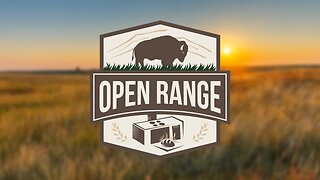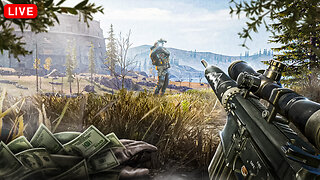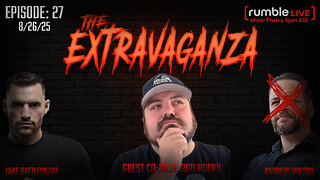Premium Only Content

LIVE - Hummingbird Cam2022
Previously Recorded Live Feed - Hummingbirds on Cougar Ridge Ranch
More Details @CougarRidgeRanch.com
This feed goes live at first light & stops at last light.
The best viewing time is at Dawn & Dusk when they are all drinking but they are at the feeders during all the daylight hours.
We apologize that we can't give you any better quality resolution but this is as much bandwidth as we have in the mountains.
Cougar Ridge Ranch is the summer breeding ground
for 4 species of hummingbirds (listed below).
Typically we have hundreds if not thousands of birds through the summer.
We usually have to fill our 8 - 80oz feeders & 13 smaller feeders every day with 4-5 gallons of sugar water. Yes we typically go through 15-20 25lb bags of white sugar every summer just feeding hummingbirds.
This year in late may the hummingbirds were here in record numbers, they were like a hive of bees swarming the feeders but then we had 5 nights that fell below 20°F & all of a sudden, after the 2nd night we noticed fewer and fewer birds.
We found little dead hummingbirds all over the ground under trees & after the 5th night we only had as many as 10 birds feeding.
All of our neighbors for miles around noticed the drop off in bird numbers.
It was such a loss that we took down all but 3 of our big feeders.
As the summer goes on, about the first to middle of July & August we should see the numbers increase as the baby birds fledge & leave the nests.
Notice that all of the territorial males will leave the young hummingbirds alone on the feeders. They seem to sense the clumsy flying and perching skills.
You'll also notice that they're much smaller than the adults for the first couple of weeks.
About Mid August we will also see the population explode as the hummingbirds from much farther north begin arriving, already on their migration.
They'll hang out & sip the swagga and rest up for their next leg south.
By Labor Day 99% of the hummingbirds have left on their migration south (usually Aug 20-25). It's an all at once event & it happens just after dawn.
If you're lucky enough to see it, it looks like a cloud of tiny birds leaving.
There are stragglers that stay behind, some even until mid October, usually females with late hatches and small chicks. We seldom see any males after the mass exodus & then the area around the feeders is calm & pleasant with no males fighting. Just females and juveniles.
We've had them hang around until the temps are getting close to freezing at night & then POOF! They're gone all at once too.
They head south to Arizona, California and Mexico for the winter & the males will arrive again in April and the females will arrive in May.
HUMMINGBIRDS ON THE RANCH
=============
BLACK CHINNED [Archilochus alexandri]
=============
A medium sized bird about 4" in length
Males have a velvety black throat with a thin, iridescent purple gorget (throat) Females have a pale throat
Both have dull metallic green on their flanks with dull metallic green above & dull grayish-white below.
Males are extremely territorial & court females by swooping down from 65 to 100 feet then powering back up.
When other males (or females) encroach in their territory they will dart side to side 3-4 feet making as much noise with their wings as possible.
They will chase other hummingbirds even making contact collisions to make their point.
=============
BROAD TAIL [Selasphorus platycercus](looks like Ruby Throated)
=============
The broad-tailed hummingbird is a medium sized bird about 4" in length. It is one of the seven species of Selasphorus including the Rufous and Calliope.
Males have a ruby gorget (throat) and both male & female have iridescent green backs & crowns with white breasts.
=============
RUFOUS [Selasphorus rufus] (very dominant RED birds)
=============
The rufous hummingbird is a small bird about 8cm (3") long. They weight 2-5grams. They have a long slender and very straight bill.
They are one of the feistiest of all the hummingbirds, probably because they arrive late in the territorial season and need to be dominant to get a place.
Males have an iridescent rufous (very rusty red) face, back, flanks & tail with a white breast. Some rufous males have an iridescent green back &/or crown.
Females have green backs & upper parts with some white showing. They have white breasts & some iridescent red/orange feathers on their throat. They have a dark tail with white tips & a red rufous base.
They are incredible distance fliers known for flying 2,000 miles during migration.
They usually arrive a few weeks late to their summer breeding grounds but with their feisty attitudes quickly take over feed sources.
They are very territorial & willing to fight any bird that is on a feed source that they claim with hard airborne contact.
=============
CALLIOPE [Selasphorus calliope] (the second smallest of all of the hummingbirds)
=============
Males have white and bright red wine colored vertical striped throats
Females have light dotted throat stripes
-

Stephen Gardner
1 hour ago🚨BREAKING: Trump FURIOUS Over Kamala’s Latest Move – SHOCKING Details!
1.81K7 -
 8:00:13
8:00:13
Dr Disrespect
9 hours ago🔴LIVE - DR DISRESPECT - GEARS RELOADED GLOBAL LAUNCH - CRUSHING LOCUST
97.6K13 -
 LIVE
LIVE
SpartakusLIVE
6 hours ago$20,000 Hide and Seek Tourney w/ Stonemountain64 || #1 Rat wins the BIG CHEESE
349 watching -
 57:00
57:00
BEK TV
22 hours agoOpen Range
1.6K -
 1:06:27
1:06:27
BonginoReport
4 hours agoBig Bad JB Threatens Trump! - Nightly Scroll w/ Hayley Caronia (Ep.120) - 08/26/2025
95.4K40 -
 1:02:26
1:02:26
Kim Iversen
4 hours agoIran Rejects Nuclear ‘Spy’ Inspectors — War Next?
40.2K88 -

StoneMountain64
8 hours agoWARZONE LEGEND RETURNS. GHILLIE SUIT $20k TOURNEY.
60.8K3 -
 1:06:33
1:06:33
TheCrucible
4 hours agoThe Extravaganza! EP: 27 with Guest Host: Rob Noerr (8/26/25)
33.2K3 -

GloryJean
10 hours agoHide & Seek Tournament w/ Spartakus, StoneMountain64 & Stevie
20.8K -

Reidboyy
7 hours ago $0.25 earnedNEW FREE FPS OUT ON CONSOLE NOW! (Delta Force = BF6 with Killstreaks)
12.7K